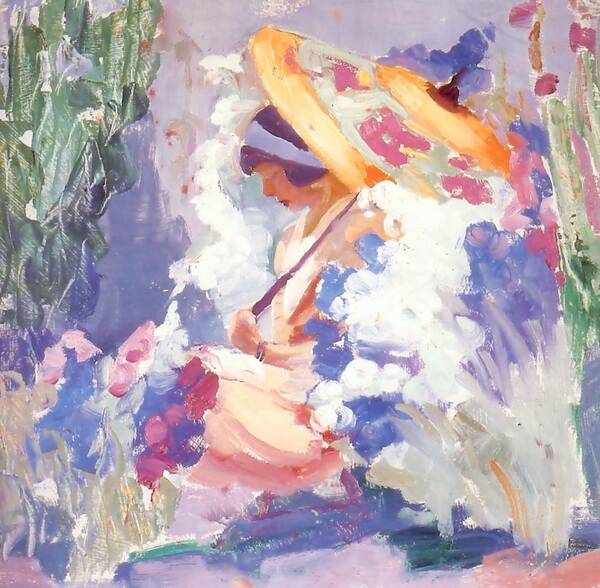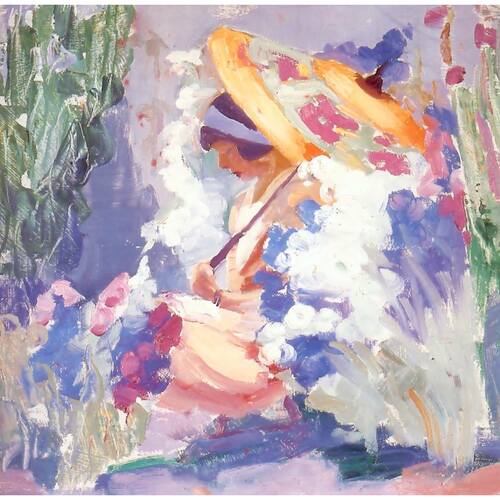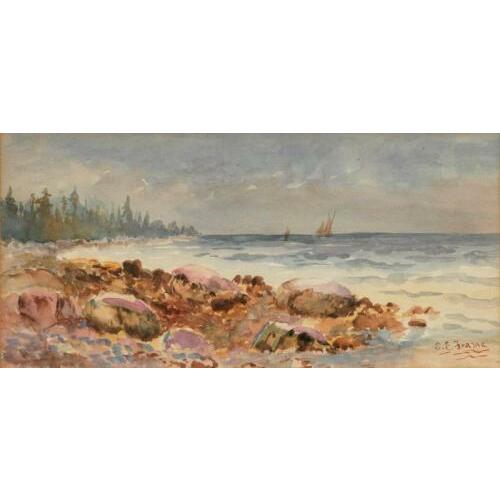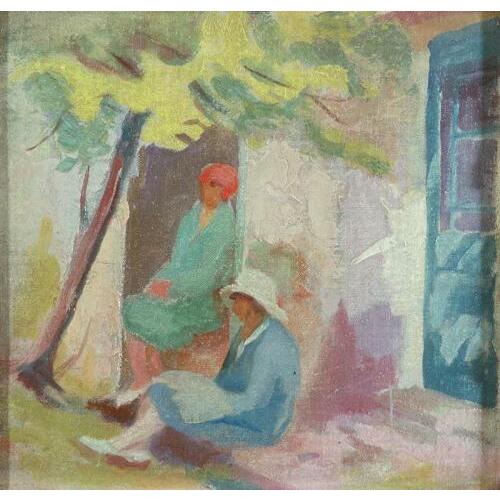
Source: Link
WELLS, Statira Elizabeth (Frame), painter; b. probably on 15 Sept. 1858 in Granby, Lower Canada, daughter of John D. Wells and Sarah Whitten Door; m. c. 1892 William Frame (d. 1941), and they had at least one daughter; d. 29 Nov. 1935 in Vancouver.
Details of Statira Elizabeth Wells’s early life remain uncertain. After her marriage to William Frame around 1892 she moved to Vancouver, where she would remain until her death. In the mid 1890s her husband worked there as a bookkeeper for the Hastings Saw Mill Store. Apart from attending a few classes in clay modelling at the Vancouver Night School, Frame was initially a self-taught artist. She began to exhibit her work with the Studio Club in 1909. Her investigation of post-Impressionism, the style that would define the rest of her artistic practice, began in 1912 when artist Emily Carr* stayed with the Frames shortly after her return from France. Carr, freshly equipped with knowledge of post-Impressionism and Fauvism, almost certainly shared these new aesthetic possibilities during the three weeks she was with the Frames. She and Frame spent time sketching together in the attic of the family home.
In 1918 Frame’s experiments in oil with shape and colour on small canvases received positive critical feedback from Robert Henri, a prominent member of New York’s Ashcan School, to whom she had submitted them for review. Henri praised her sense of composition and form, but reserved his highest compliments for her use of colour. He suggested that while most people see only colour and more colour, Frame was cognizant of what happens between colours, and he encouraged her not to change any aspect of her technique.
Frame’s work matured in the 1920s. About 1919–20 she travelled to Monterey, Calif., to study with American Impressionist Armin Carl Hansen; it was the first of only two major trips that she would make outside Vancouver after her arrival there. She spent about three to four months with Hansen, who, like Henri, approved of her style but who urged her to increase the size of her paintings. Until then, she had generally used 7-by-12-inch canvases.
During the 1920s Frame became an active member of the British Columbia Society of Fine Arts and the Vancouver Sketch Club; during her exhibitions with both organizations, critics acknowledged her as a “modern” artist with “colourful paintings in the newest of the new methods.” In a show sponsored by the club in June 1920, she was cited by the Vancouver Daily Province as one of the few who cleverly represented Impressionism’s advanced style.
In 1926 Frame became secretary-treasurer of the newly organized Palette and Chisel Club, founded by artists who sought to occupy a niche between the Group of Seven and the academic painters. While members of the club ultimately did not exhibit work that was more modern than that shown by the British Columbia Society of Fine Arts, the presence of Modernists in both organizations signalled a shift away from conservatism in Vancouver art circles. The public slowly accepted the fluent brushstrokes, the sensibility to colour, and the freer, more expressive style that Frame used. During that year she made her second and last journey outside Vancouver, to Alert Bay on Vancouver Island, where she spent a month painting.
Frame continued to exhibit locally throughout the mid 1920s and early 1930s. She focused almost exclusively on outdoor scenes from Vancouver and its environs, including Stanley Park, Burrard Inlet, and the Fraser valley. In her translation of these views into patches of colour, her work moves away from the actual depiction of place to the experience of colour and the emotions it nurtures. In particular, her high-keyed tones suggest that she was concerned with illustrating the sun and its effects. The light in her canvases imbues her work with a feeling of joy that was praised by both Carr and another Vancouver painter, Harold Mortimer Lamb*, in their reflections during the retrospective exhibition held by the Vancouver Art Gallery in April 1936, less than six months after her death.
Statira Frame contributed to the introduction of Modernism to Vancouver at a time when the preference was for watercolours and landscapes of the British academic school. Her artistic production has been recognized posthumously as being progressive and forward-looking.
Paintings by Statira Elizabeth Wells Frame can be found in the Art Gallery of Greater Victoria, the Vancouver Art Gallery, and the BCA and in private collections.
Information on her early life has been difficult to uncover. For the registration of her death (BCA, GR-2951, no.1935-09-508102), her daughter gave the names of her mother’s parents and indicated that she was born in Lower Canada in 1863, but no corresponding registration of birth or baptism has been found. Royal Canadian Academy of Arts: exhibitions and members, 1880–1979, comp. E. de R. McMann (Toronto, 1981), states that she was born in Waterloo, Que., on 15 Sept. 1870 and that place and year of birth have been repeated in numerous secondary sources. The only mention of her located in census records (LAC, Census returns for the 1911 Canadian census, Vancouver, subdist.63: 21), has Sept. 1871 as her date of birth. Yet her name and those of her parents correspond exactly to the registration of baptism of a child born in Granby, Lower Canada, on 15 Sept. 1858 (BANQ-E, CE502, S42, 7 août 1859).
BCA, GR-2951, no.1941-09-589184. Vancouver Daily Province, 22 Sept. 1919; 5 June 1920; 18 Feb., 28 April 1928; 29 Nov. 1935. The collector’s dictionary of Canadian artists at auction, ed. A. R. Westbridge and D. L. Bodnar (4v., Vancouver, 1999–2003), 1. Directory, Vancouver, 1896. W. W. Thom, “The fine arts in Vancouver, 1886–1930: an historical survey” (ma thesis, Univ. of B.C., Vancouver, 1969). Maria Tippett, By a lady: celebrating three centuries of art by Canadian women (Toronto, 1992). Maria Tippett and Douglas Cole, From desolation to splendour: changing perceptions of the British Columbia landscape (Toronto, 1977). Nicholas Tuele et al., British Columbia women artists: 1885–1985, ed. Judith Alldritt-McDowell (exhibition catalogue, Art Gallery of Greater Victoria, 1985).
Cite This Article
Christian Monks, “WELLS, STATIRA ELIZABETH (Frame),” in Dictionary of Canadian Biography, vol. 16, University of Toronto/Université Laval, 2003–, accessed January 19, 2026, https://www.biographi.ca/en/bio/wells_statira_elizabeth_16E.html.
The citation above shows the format for footnotes and endnotes according to the Chicago manual of style (16th edition). Information to be used in other citation formats:
| Permalink: | https://www.biographi.ca/en/bio/wells_statira_elizabeth_16E.html |
| Author of Article: | Christian Monks |
| Title of Article: | WELLS, STATIRA ELIZABETH (Frame) |
| Publication Name: | Dictionary of Canadian Biography, vol. 16 |
| Publisher: | University of Toronto/Université Laval |
| Year of publication: | 2015 |
| Year of revision: | 2015 |
| Access Date: | January 19, 2026 |





